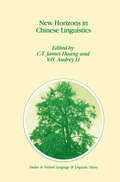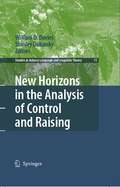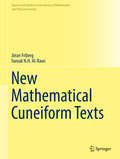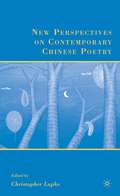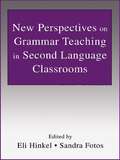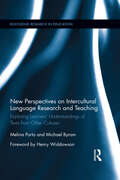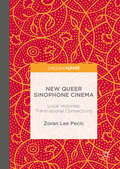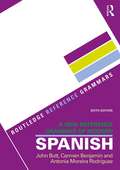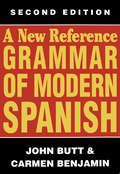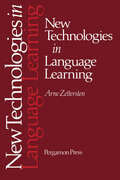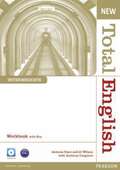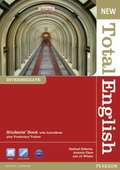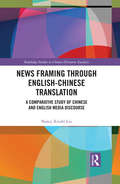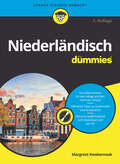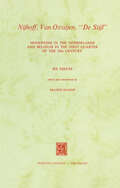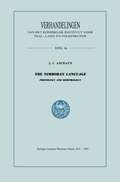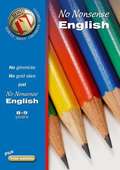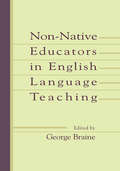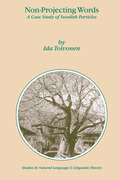- Table View
- List View
New Horizons in Chinese Linguistics (Studies in Natural Language and Linguistic Theory #36)
by Liliane HaegemanThe past decade and a half has witnessed a great deal of renewed interest in the study of Chinese linguistics, not only in the traditional areas of philological studies and in theoretically oriented areas of syn chronic grammar and language change but also in the cultivation of new frontiers in related areas of the cognitive sciences. There is a significant increase in the number of students studying one area or another of the linguistic structure of Chinese in various linguistic programs in the United States, Europe, Australia and in China, Hong Kong, Singapore, Taiwan, and other parts of Asia. Several new academic departments devoted to the study of linguistics have been established in Taiwan and Hong Kong in the past few years. The increasing research and study activities have also resulted in a number of national and international conferences, including the North American Conference on Chinese Linguistics (NACCL), which has been held annually in the United States; the International Symposium on Chinese Languages and Linguistics (IsCLL), which has had its fourth meeting since it was launched by Academia Sinica in Taiwan in 1990; the International Association of Chinese Linguistics (lACL), created in Singapore in 1992 and now incorporated in Irvine, California, which has held its annual meetings at major institutions in Asia, Europe, and the US.
New Horizons in the Analysis of Control and Raising (Studies in Natural Language and Linguistic Theory #71)
by William D. Davies Stanley DubinskyRaising and control have figured in every comprehensive model of syntax for forty years. Recent renewed attention to them makes this collection a timely one. The contributions, representing some of the most exciting recent work, address many fundamental research questions. What beside the canonical constructions might be subject to raising or control analyses? What constructions traditionally treated as raising or control might not actually be so? What classes of control must be recognized? How do tense, agreement, or clausal completeness figure in their distribution? The chapters address these and other relevant issues, and bring new empirical data into focus.
New Mathematical Cuneiform Texts (Sources and Studies in the History of Mathematics and Physical Sciences)
by Jöran Friberg Farouk N.H. Al-RawiThis monograph presents in great detail a large number of both unpublished and previously published Babylonian mathematical texts in the cuneiform script. It is a continuation of the work A Remarkable Collection of Babylonian Mathematical Texts (Springer 2007) written by Jöran Friberg, the leading expert on Babylonian mathematics.Focussing on the big picture, Friberg explores in this book several Late Babylonian arithmetical and metro-mathematical table texts from the sites of Babylon, Uruk and Sippar, collections of mathematical exercises from four Old Babylonian sites, as well as a new text from Early Dynastic/Early Sargonic Umma, which is the oldest known collection of mathematical exercises. A table of reciprocals from the end of the third millennium BC, differing radically from well-documented but younger tables of reciprocals from the Neo-Sumerian and Old-Babylonian periods, as well as a fragment of a Neo-Sumerian clay tablet showing a new type of a labyrinth are also discussed. The material is presented in the form of photos, hand copies, transliterations and translations, accompanied by exhaustive explanations. The previously unpublished mathematical cuneiform texts presented in this book were discovered by Farouk Al-Rawi, who also made numerous beautiful hand copies of most of the clay tablets.Historians of mathematics and the Mesopotamian civilization, linguists and those interested in ancient labyrinths will find New Mathematical Cuneiform Texts particularly valuable. The book contains many texts of previously unknown types and material that is not available elsewhere.
New Perspectives on Contemporary Chinese Poetry
by C. LupkeThis book brings together fresh research from experts on contemporary Chinese poetry, built upon one of the most glorious poetic traditions of any civilization in the world yet historically neglected by scholars in English. This comprehensive volume offers readable and provocative treatments of many of the most important Chinese poets of our age.
New Perspectives on Grammar Teaching in Second Language Classrooms
by Eli Hinkel Sandra FotosNew Perspectives on Grammar Teaching in Second Language Classrooms brings together various approaches to the contextualized teaching of grammar and communicative skills as integrated components of second language instruction. Its purpose is to show from both theoretical and practical perspectives that grammar teaching can be made productive and useful in ESL and EFL classrooms. In this text: *First-rate scholars approach the teaching of grammar from multiple complementary perspectives, providing an original, comprehensive treatment of the topic. *Discourse analysis and research data are used to address such pedagogical areas as grammatical and lexical development in speaking, listening, reading, and writing. *The communicative perspective on ESL and EFL instruction that is presented provides ways for learners to enhance their production skills, whereas the meaning-based grammar instruction can supplement and strengthen current methodology with a communicative focus. This volume is intended as a foundational text for second language grammar pedagogy courses at the advanced undergraduate and master's levels.
New Perspectives on Grammar Teaching in Second Language Classrooms
by Eli Hinkel Sandra FotosNew Perspectives on Grammar Teaching in Second Language Classrooms brings together various approaches to the contextualized teaching of grammar and communicative skills as integrated components of second language instruction. Its purpose is to show from both theoretical and practical perspectives that grammar teaching can be made productive and useful in ESL and EFL classrooms. In this text: *First-rate scholars approach the teaching of grammar from multiple complementary perspectives, providing an original, comprehensive treatment of the topic. *Discourse analysis and research data are used to address such pedagogical areas as grammatical and lexical development in speaking, listening, reading, and writing. *The communicative perspective on ESL and EFL instruction that is presented provides ways for learners to enhance their production skills, whereas the meaning-based grammar instruction can supplement and strengthen current methodology with a communicative focus. This volume is intended as a foundational text for second language grammar pedagogy courses at the advanced undergraduate and master's levels.
New Perspectives on Intercultural Language Research and Teaching: Exploring Learners’ Understandings of Texts from Other Cultures (Routledge Research in Education)
by Michael Byram Melina PortoIllustrated by an empirical study of English as a Foreign Language reading in Argentina, this book argues for a different approach to the theoretical rationales and methodological designs typically used to investigate cultural understanding in reading, in particular foreign language reading. It presents an alternative approach which is more authentic in its methods, more educational in its purposes, and more supportive of international understanding as an aim of language teaching in general and English language teaching in particular.
New Perspectives on Intercultural Language Research and Teaching: Exploring Learners’ Understandings of Texts from Other Cultures (Routledge Research in Education)
by Michael Byram Melina PortoIllustrated by an empirical study of English as a Foreign Language reading in Argentina, this book argues for a different approach to the theoretical rationales and methodological designs typically used to investigate cultural understanding in reading, in particular foreign language reading. It presents an alternative approach which is more authentic in its methods, more educational in its purposes, and more supportive of international understanding as an aim of language teaching in general and English language teaching in particular.
New Queer Sinophone Cinema: Local Histories, Transnational Connections
by Zoran Lee PecicThis book looks closely at some of the most significant films within the field of queer Sinophone cinema. Examining queerness in films produced in the PRC, Taiwan and Hong Kong, the book merges the Sinophone with the queer, theorising both concepts as local and global, homebound as well as diasporic. Queerness in this book not only problematises the positioning of non-normative desires within the Sinophone; it also challenges Eurocentric critical perspectives on filmic representation that are tied to the idea of the binary between East/West. New Queer Sinophone Cinema will appeal to scholars in Chinese and film studies, as well as to anyone who is interested in queer Chinese cinema.
A New Reference Grammar of Modern Spanish
by John B. Butt Carmen Benjamin Moreira-Rodriguez AntoniaA New Reference Grammar of Modern Spanish is a comprehensive, cohesive and clear guide to the forms and structures of Spanish as it is written and spoken today in Spain and Latin-America. It includes clear descriptions of all the main grammatical phenomena of Spanish, and their use, illustrated by numerous examples of contemporary Spanish, both Peninsular and Latin-American, formal and informal. Fully revised and updated, the sixth edition is even more relevant to students and teachers of Spanish. The sixth edition includes: • new chapters, providing more detail and examples of key areas of Spanish grammar; • an increased number of Mexican examples to reflect the growing interest in this country’s variety of Spanish; • new information for readers studying Spanish and French together; • a glossary of grammatical terms including English translations of Spanish terms. The combination of reference grammar and manual of current usage is invaluable for learners at level B2–C2 of the Common European Framework for Languages, and Intermediate High–Advanced High on the ACTFL proficiency scales.
A New Reference Grammar of Modern Spanish (Routledge Reference Grammars Ser.)
by John B. Butt Carmen Benjamin Moreira-Rodriguez AntoniaA New Reference Grammar of Modern Spanish is a comprehensive, cohesive and clear guide to the forms and structures of Spanish as it is written and spoken today in Spain and Latin-America. It includes clear descriptions of all the main grammatical phenomena of Spanish, and their use, illustrated by numerous examples of contemporary Spanish, both Peninsular and Latin-American, formal and informal. Fully revised and updated, the sixth edition is even more relevant to students and teachers of Spanish. The sixth edition includes: • new chapters, providing more detail and examples of key areas of Spanish grammar; • an increased number of Mexican examples to reflect the growing interest in this country’s variety of Spanish; • new information for readers studying Spanish and French together; • a glossary of grammatical terms including English translations of Spanish terms. The combination of reference grammar and manual of current usage is invaluable for learners at level B2–C2 of the Common European Framework for Languages, and Intermediate High–Advanced High on the ACTFL proficiency scales.
A New Reference Grammar of Modern Spanish
by John Butt Carmen Benjamin(abridged and revised) This reference grammar offers intermediate and advanced students a reason ably comprehensive guide to the morphology and syntax of educated speech and plain prose in Spain and Latin America at the end of the twentieth century. Spanish is the main, usually the sole official language of twenty-one countries,} and it is set fair to overtake English by the year 2000 in numbers 2 of native speakers. This vast geographical and political diversity ensures that Spanish is a good deal less unified than French, German or even English, the latter more or less internationally standardized according to either American or British norms. Until the 1960s, the criteria of internationally correct Spanish were dictated by the Real Academia Espanola, but the prestige of this institution has now sunk so low that its most solemn decrees are hardly taken seriously - witness the fate of the spelling reforms listed in the Nuevas normas de prosodia y ortograjia, which were supposed to come into force in all Spanish-speaking countries in 1959 and, nearly forty years later, are still selectively ignored by publishers and literate persons everywhere. The fact is that in Spanish 'correctness' is nowadays decided, as it is in all living languages, by the consensus of native speakers; but consensus about linguistic usage is obviously difficult to achieve between more than twenty independent, widely scattered and sometimes mutually hostile countries. Peninsular Spanish is itself in flux.
New Technologies in Language Learning
by A. ZetterstenThis is the first book to provide a comprehensive survey of the use of new technologies in language learning. In order to explain how new technologies open up possibilities for language learning, numerous practical experiments made with various electronic media are analysed. They include the use of microcomputers, videotex (viewdata), teletext, video and videodiscs. In addition, artificial intelligence, synthetic speech, robots, distance education, language testing as well communicative training and the problem of accuracy and fluency are dealt with.
New Total English Intermediate (PDF)
by Anthony Cosgrove Mark Foley Diane Hall Diane HallThis edition is a well organized 6 level general English course for adults with clear learning aims making it easy for ELT teachers to plan lessons and measure students progress.
New Total English Intermediate (PDF)
by Rachael Roberts J. J. Wilson Antonia Clare Mark Foley Diane Hall Diane HallThis edition is a well organized 6 level general English course for adults with clear learning aims making it easy for ELT teachers to plan lessons and measure students progress.
News Framing through English-Chinese Translation: A Comparative Study of Chinese and English Media Discourse (Routledge Studies in Chinese Discourse Analysis)
by Nancy Xiuzhi LiuNews Framing Through English-Chinese Translation provides a useful tool to depict how Chinese news translation can be examined in the era of globalization. The author has integrated framing theory in journalism studies with translation studies and developed a new theoretical model/framework named Transframing. This interdisciplinary model is pioneering and will make theoretical and conceptual contributions to translation studies. This book aims to reveal ideological, sociocultural and linguistic factors creating media discourse by examining Chinese media discourse, in comparison to its counterpart in English. Through the analysis of both quantitative and qualitative methods, it is concluded that the transframing model can be applied to interpreting, describing, explaining as well as predicting the practice of news translation.
News Framing through English-Chinese Translation: A Comparative Study of Chinese and English Media Discourse (Routledge Studies in Chinese Discourse Analysis)
by Nancy Xiuzhi LiuNews Framing Through English-Chinese Translation provides a useful tool to depict how Chinese news translation can be examined in the era of globalization. The author has integrated framing theory in journalism studies with translation studies and developed a new theoretical model/framework named Transframing. This interdisciplinary model is pioneering and will make theoretical and conceptual contributions to translation studies. This book aims to reveal ideological, sociocultural and linguistic factors creating media discourse by examining Chinese media discourse, in comparison to its counterpart in English. Through the analysis of both quantitative and qualitative methods, it is concluded that the transframing model can be applied to interpreting, describing, explaining as well as predicting the practice of news translation.
Niederländisch für Dummies (Für Dummies)
by Margreet Kwakernaak"Niederländisch für Dummies" bietet einen leichten Einstieg in die niederländische Sprache. Nach einer Einführung in die sprachlichen Besonderheiten, die Aussprache und die Grammatik wird es auch schon praktisch: Jedes Kapitel beschäftigt sich mit einer Alltagssituation. Sie lernen, wie Sie sich auf Niederländisch vorstellen, im Restaurant Essen bestellen oder ein Hotelzimmer reservieren. Ganz nebenbei erhalten Sie viele Informationen zu Alltag und Kultur in den Niederlanden. Am Ende jedes Kapitels gibt es eine kleine Übung, mit der Sie Ihre neu erworbenen Sprachkenntnisse prüfen können.
Nijhoff, Van Ostaijen, "De Stijl": Modernism in the Netherlands and Belgium in the First Quarter of the 20th Century. Six Essays
by F. BulhofFRANCIS BULHOF "What was Modernism?" That is the title of an address delivered in June of 1960 by the eminent comparatist Harry Levin at Queen's University in King ston, Ontario.1 Apparently, more than a decade ago, in the eyes of this per ceptive analyst of literature and the arts, the modernist movement had become a thing of the past. Having acquired full citizenship in the republic of letters, modernism had outlived itself. The title of Harry Levin's lecture bears an obvious resemblance to that of Fritz Martini's book-length essay Was war Expressionismus?,2 which dealt exclusively with the German variant of the expressionist movement. In the case of German expressionism there is much dispute concerning the precise moment of its decline and fall, but the political conditions provide at least a crucial dividing line in the year 1933. The end of modernism, however, a far more comprehensive movement which was not just limited to one country, is not so easy to determine. And there is also still much discussion about its roots.
The Nimboran Language: Phonology and Morphology (Verhandelingen van het Koninklijk Instituut voor Taal-, Land- en Volkenkunde)
by J. C. AnceauxNo Nonsense English 8-9 Years (PDF)
by Frances Orchard Helen HadleyBond No Nonsense is the home learning series clearly differentiated from the competition, that concentrates on teaching and building real skills in maths and English under the brand promise 'serious about your child's learning'.
Non-native Educators in English Language Teaching
by George BraineThe place of native and non-native speakers in the role of English teachers has probably been an issue ever since English was taught internationally. Although ESL and EFL literature is awash, in fact dependent upon, the scrutiny of non-native learners, interest in non-native academics and teachers is fairly new. Until recently, the voices of non-native speakers articulating their own concerns have been even rarer. This book is a response to this notable vacuum in the ELT literature, providing a forum for language educators from diverse geographical origins and language backgrounds. In addition to presenting autobiographical narratives, these authors argue sociopolitical issues and discuss implications for teacher education, all relating to the theme of non-native educators in ETL. All of the authors are non-native speakers of English. Some are long established professionals, whereas others are more recent initiates to the field. All but one received part of the higher education in North America, and all except two of the chapters are at least partially contextualized in North America. Particularly relevant for non-native speakers who aspire to enter the profession, graduate students in TESOL programs, and teacher educators, the unique nature of this book's contributors and its contents will interest researchers and professionals in applied linguistics generally and in ELT, and all those who are concerned with the role of non-native speakers in English-language teaching.
Non-native Educators in English Language Teaching
by George BraineThe place of native and non-native speakers in the role of English teachers has probably been an issue ever since English was taught internationally. Although ESL and EFL literature is awash, in fact dependent upon, the scrutiny of non-native learners, interest in non-native academics and teachers is fairly new. Until recently, the voices of non-native speakers articulating their own concerns have been even rarer. This book is a response to this notable vacuum in the ELT literature, providing a forum for language educators from diverse geographical origins and language backgrounds. In addition to presenting autobiographical narratives, these authors argue sociopolitical issues and discuss implications for teacher education, all relating to the theme of non-native educators in ETL. All of the authors are non-native speakers of English. Some are long established professionals, whereas others are more recent initiates to the field. All but one received part of the higher education in North America, and all except two of the chapters are at least partially contextualized in North America. Particularly relevant for non-native speakers who aspire to enter the profession, graduate students in TESOL programs, and teacher educators, the unique nature of this book's contributors and its contents will interest researchers and professionals in applied linguistics generally and in ELT, and all those who are concerned with the role of non-native speakers in English-language teaching.
Non-Projecting Words: A Case Study of Swedish Particles (Studies in Natural Language and Linguistic Theory #58)
by I. ToivonenFocusing primarily on Swedish, a Germanic language whose particles have not previously been studied extensively, this study develops a theory of non-projecting words in which particles are morphologically independent words that do not project phrases. It identifies the violations of the basic tenets of X-bar theory and develops a formally explicit revision of X-bar theory that can accommodate the requisite "weak" projections.
Nonnative Speaker English Teachers: Research, Pedagogy, and Professional Growth (ESL & Applied Linguistics Professional Series)
by George BraineAccording to current estimates, about eighty percent of English teachers worldwide are nonnative speakers of the language. The nonnative speaker movement began a decade ago to counter the discrimination faced by these teachers and to champion their causes. As the first single-authored volume on the topic since the birth of the movement, this book fills the need for a coherent account that: traces the origins and growth of the movement summarizes the research that has been conducted highlights the challenges faced by nonnative speaker teachers promotes NNS teachers’ professional growth. No discussion of world Englishes or the spread of English internationally is now complete without reference to the NNS movement. This book celebrates its first decade and charts a direction for its growth and development.
